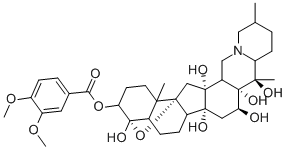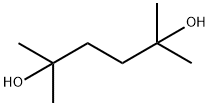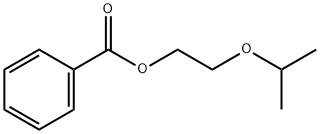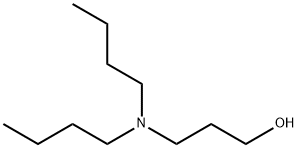Veratridine , ≥98% , 71-62-5
Synonym(s):
3-Veratroylveracevine;Veracevine veratrate;Veratridine - CAS 71-62-5 - Calbiochem
CAS NO.:71-62-5
Empirical Formula: C36H51NO11
Molecular Weight: 673.79
MDL number: MFCD16661233
EINECS: 200-758-4
| Pack Size | Price | Stock | Quantity |
| 5mg | RMB1118.40 | In Stock |
|
| 10mg | RMB1843.20 | In Stock |
|
| others | Enquire |
PRODUCT Properties
| Melting point: | 180℃ |
| alpha | D20 +8.0° (ethanol) |
| Boiling point: | 689.74°C (rough estimate) |
| Density | 1.45±0.1 g/cm3 (20 ºC 760 Torr) |
| refractive index | 1.6630 (estimate) |
| storage temp. | -20°C |
| solubility | ethanol: 50 mg/mL |
| form | powder |
| pka | 9.54(at 25℃) |
| color | white to off-white |
| Merck | 13,10016 |
| BRN | 78875 |
| Stability: | Stable for 2 years from date of purchase as supplied. Solutions in DMSO or ethanol may be stored at -20°C for up to 2 months. |
| EPA Substance Registry System | Veratridine (71-62-5) |
Description and Uses
This steroidal alkaloid from Veratrum viride was given this name by Bosetti. It is almost certainly identical with the amorphous veratrine isolated by Schmidt and Koppen, Merck, and Wright and Luff. The base is a colourless, amorphous powder which melts over a wide range. It has [α]22D + 8.0° (EtOH) and yields a sulphate nonahydrate which forms colourless silky needles that resinify in air. The nitrate is only sparingly soluble in H2O. The solution of the alkaloid in H2SO4 becomes orange-red and eventually crimson with a blue fluorescence while that in HCI is colourless. Alkaline hydrolysis furnishes veratric acid and cevine.
Veratridine causes Na+ channels to stay open during a sustained membrane depolarization by abolishing inactivation.?This, in turn, opens voltage-activated calcium channels, thus increasing intracellular calcium content and inducing neurotransmitter release. Alkaloid neurotoxin which depolarizes excitable tissue; used to increase membrane sodium permeability.
Safety
| Symbol(GHS) |  GHS06 |
| Signal word | Danger |
| Hazard statements | H300+H310+H330-H315-H319-H335 |
| Precautionary statements | P260-P262-P280-P302+P352+P310-P304+P340+P310-P305+P351+P338 |
| Hazard Codes | T+ |
| Risk Statements | 26/27/28-36/37/38-62-52/53-48/20 |
| Safety Statements | 26-36/37/39-45-61-36/37-28 |
| RIDADR | UN 1544 6.1/PG 1 |
| WGK Germany | 2 |
| RTECS | YX5600000 |
| F | 10 |
| HazardClass | 6.1(a) |
| PackingGroup | II |
| Hazardous Substances Data | 71-62-5(Hazardous Substances Data) |
| Toxicity | LD50 in mice (mg/kg): 1.35 i.p. (Swiss, Bauer); 0.42 i.v. (Krayer); 6.3 s.c. (Tanaka) |





